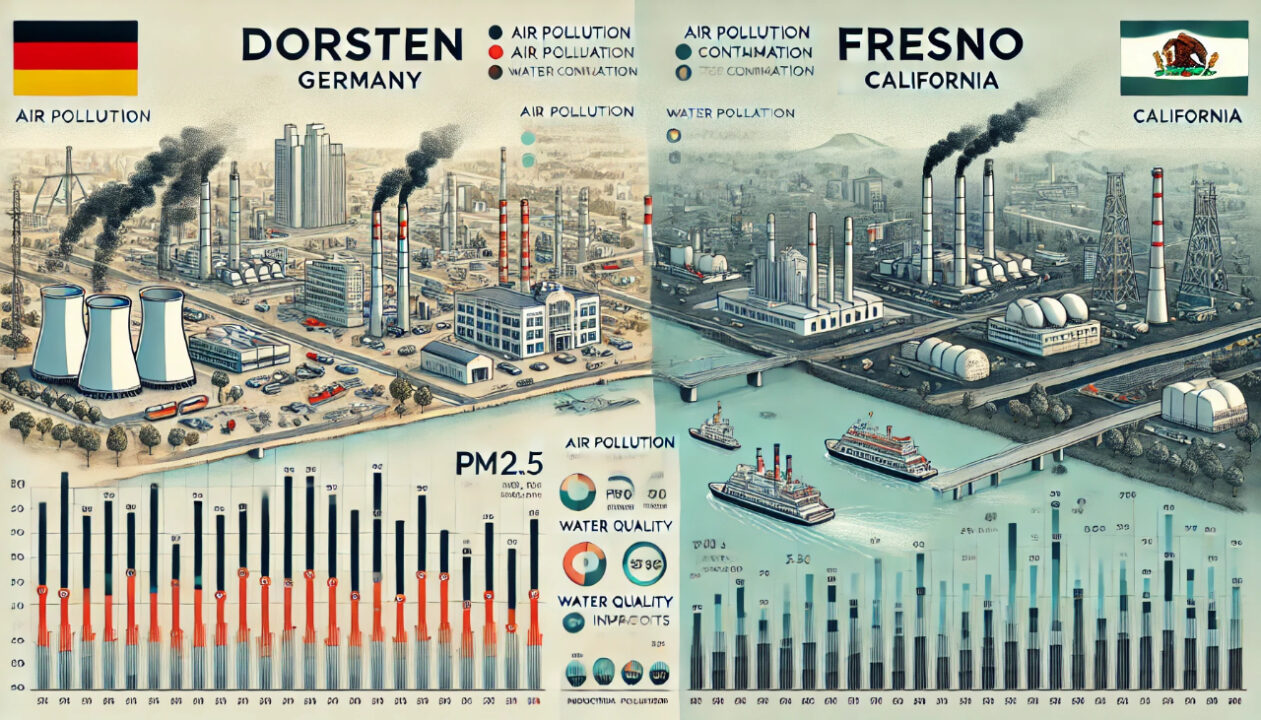The comparison of pollution levels between two cities can reveal valuable insights into environmental health and urban living conditions. This Dorsten vs Fresno pollution comparison chart will analyze the air quality, water pollution, and overall environmental impact of these two distinct cities—Dorsten, Germany, and Fresno, California. Each city faces unique environmental challenges based on geographic location, industrial activity, and governmental regulations. Understanding the disparities and similarities between Dorsten and Fresno offers a closer look at how urban centers can tackle pollution more effectively.
Dorsten vs Fresno Pollution Comparison Chart: Why It Matters
Comparing pollution levels between cities like Dorsten and Fresno is critical for various reasons. Urbanization, industrialization, and population growth all contribute to the environmental footprint of a city. When comparing pollution in Dorsten and Fresno, the conversation expands beyond mere numbers—it becomes about the overall quality of life, public health, and long-term sustainability.
You May Also Like: Eve online battleship fleet lost to ncp bubbled by goons
The Dorsten vs Fresno pollution comparison chart sheds light on which city has cleaner air, less water contamination, and how their respective populations are impacted by pollution.
Air Pollution: Dorsten vs Fresno
Air pollution is one of the most significant indicators of a city’s environmental health. Both Dorsten and Fresno experience varying levels of air pollution, but their causes and impacts differ substantially.
In Dorsten, a relatively small town in Germany’s North Rhine-Westphalia region, air pollution mainly stems from local industries and transportation. However, stringent European Union regulations have helped maintain moderate pollution levels over the years. According to recent data, Dorsten’s average annual PM2.5 levels (fine particulate matter) hover around 15 µg/m³, which is considered moderate but safe by EU standards. Occasional spikes occur due to nearby industrial activities, but these are well-controlled through strict enforcement.
Fresno, located in California’s Central Valley, faces more severe air pollution challenges. The geography of the valley traps pollutants, contributing to higher concentrations of particulate matter and ozone. Fresno’s average PM2.5 levels regularly exceed 30 µg/m³, which falls into the unhealthy category, particularly during the summer months when wildfires exacerbate the problem. Additionally, Fresno’s reliance on vehicular transportation contributes significantly to its air quality woes.
While Dorsten benefits from stringent EU air quality regulations, Fresno struggles with unique geographical and industrial challenges that compound its pollution levels.
Water Pollution Comparison Between Dorsten and Fresno
Water pollution is another key element when analyzing the environmental health of cities. Clean water access is vital for both residential use and agricultural practices, yet both Dorsten and Fresno face distinct challenges when it comes to maintaining water quality.
Dorsten’s water pollution is relatively low, thanks to Germany’s comprehensive water management systems. Industrial wastewater is closely monitored, and public utilities ensure that drinking water meets high European standards. However, agricultural runoff does present occasional concerns, particularly in rural areas surrounding Dorsten.
Fresno’s water pollution issues are more pronounced due to its location in an agriculturally rich region. Pesticide runoff, nitrate contamination, and aging water infrastructure pose significant threats to the city’s water quality. In addition, Fresno’s heavy agricultural industry contributes to groundwater contamination, making the water unsafe for consumption in certain areas. Fresno has made strides in water filtration and treatment, but the scale of agricultural activity complicates these efforts.
Groundwater Depletion: A Common Concern
Both Dorsten and Fresno face challenges related to groundwater depletion. Fresno, being located in a drought-prone region, relies heavily on groundwater, which has been overextracted for decades due to intensive farming practices. Groundwater levels have significantly dropped, resulting in subsidence and long-term sustainability concerns.
Dorsten’s situation is less severe but still worth noting. Groundwater management remains critical, especially in areas where agriculture and industry intersect. Although rainfall in Germany generally helps replenish water supplies, careful monitoring ensures that groundwater resources are used sustainably.
Industrial Impact: Pollution from Factories and Agriculture
Both cities are influenced by industrial pollution, but in different ways.
Dorsten has a history of being part of Germany’s coal and steel industries, which once contributed to significant pollution. However, with the decline of coal mining and the introduction of greener technologies, the city’s industrial pollution has decreased substantially. The shift towards cleaner energy sources and tighter regulations has led to a reduction in emissions from local factories.
Fresno, by contrast, is largely impacted by its agricultural sector. Industrial-scale farming, which relies heavily on chemical fertilizers and pesticides, generates substantial runoff and contributes to both air and water pollution. The processing of agricultural products also adds to the region’s pollution levels. Furthermore, the Central Valley’s poor air circulation exacerbates the problem, trapping pollutants and contributing to high ozone levels.
Population Density and Pollution Correlation
The population density of a city often correlates with pollution levels, especially regarding waste management and vehicular emissions.
Dorsten, with a population of approximately 75,000 people, experiences relatively low pollution levels compared to larger urban centers. Its moderate size allows for more effective waste management, and public transportation systems are well-developed, reducing the need for personal vehicles.
Fresno, with a population exceeding 500,000, struggles more with pollution tied to vehicular emissions. Traffic congestion, urban sprawl, and reliance on cars for transportation significantly contribute to both air and noise pollution. Despite efforts to expand public transportation, Fresno’s sprawling geography makes it difficult to reduce car dependency effectively.
How Climate Affects Pollution Levels in Dorsten and Fresno
The climate in Dorsten and Fresno plays a crucial role in determining pollution levels. Dorsten’s temperate climate, with regular rainfall, helps wash away pollutants from the air, leading to generally cleaner air conditions throughout the year. However, during cold winters, emissions from heating can contribute to temporary air quality degradation.
Fresno’s climate is much more challenging in terms of pollution control. The city experiences long, hot summers, which exacerbate ozone pollution and worsen air quality. Furthermore, the valley’s natural topography acts as a basin that traps pollutants, making it difficult for Fresno to achieve consistent improvements in air quality. Drought conditions also increase the risk of wildfires, which have become a significant source of air pollution in recent years.
Waste Management: Dorsten vs Fresno
The effectiveness of waste management systems in both Dorsten and Fresno contributes to their overall pollution levels.
Dorsten operates under strict German regulations, which mandate comprehensive recycling and waste treatment practices. These regulations ensure that waste is managed efficiently, minimizing landfill use and reducing environmental contamination. Public awareness campaigns have also encouraged citizens to participate in recycling programs, contributing to Dorsten’s reputation for effective waste management.
Fresno, while making improvements in recycling and waste management, faces challenges due to its larger population and higher consumption rates. Landfills in Fresno are under pressure, and illegal dumping remains a concern in certain areas. Although the city has made strides in composting and recycling programs, waste management continues to be an issue, contributing to local pollution levels.
Addressing the Pollution Problems: Initiatives in Dorsten and Fresno
In both cities, initiatives have been put in place to address pollution. Dorsten has benefitted from EU directives that focus on improving air and water quality. Investments in public transportation, greener energy sources, and waste management technologies have helped mitigate pollution levels. Furthermore, Dorsten’s involvement in environmental education campaigns has fostered a culture of sustainability among its citizens.
Fresno, on the other hand, faces more uphill battles due to its geography and industrial landscape. However, the city has implemented measures such as air quality alerts, stricter regulations on pesticide use, and improvements in water infrastructure. While these efforts are commendable, Fresno’s long-term success in tackling pollution will likely depend on larger state and federal initiatives aimed at reducing agricultural pollution and improving air quality in the Central Valley.
The Future Outlook for Dorsten and Fresno
The future of environmental health in Dorsten and Fresno depends on continuous investment in green technologies, regulatory improvements, and citizen participation. Dorsten appears to be on a sustainable path with its emphasis on cleaner industries and stringent environmental laws. Fresno, while making progress, must overcome significant challenges, particularly in air and water quality management. Collaborative efforts between the government, industry, and the public will be essential to ensure a cleaner and healthier future for both cities.
FAQs
What is the main difference in air quality between Dorsten and Fresno?
Dorsten experiences moderate air pollution due to stringent EU regulations, while Fresno has more severe air quality issues due to geographic factors and industrial agriculture.
How does water pollution in Fresno compare to Dorsten?
Fresno faces significant water pollution challenges due to agricultural runoff and nitrate contamination, while Dorsten benefits from stricter water management systems.
What contributes to Fresno’s higher pollution levels?
Fresno’s geography, industrial-scale farming, and reliance on vehicular transportation contribute to its higher pollution levels compared to Dorsten.
How does population density affect pollution in both cities?
Dorsten’s smaller population helps reduce vehicular emissions and waste, whereas Fresno’s larger population leads to more congestion and pollution.
Are there any efforts to reduce pollution in Dorsten?
Yes, Dorsten follows EU regulations, invests in green technologies, and promotes public transportation to reduce pollution.
What environmental challenges does Fresno face?
Fresno faces challenges like air pollution, water contamination, and waste management, compounded by its location in a drought-prone agricultural region.





